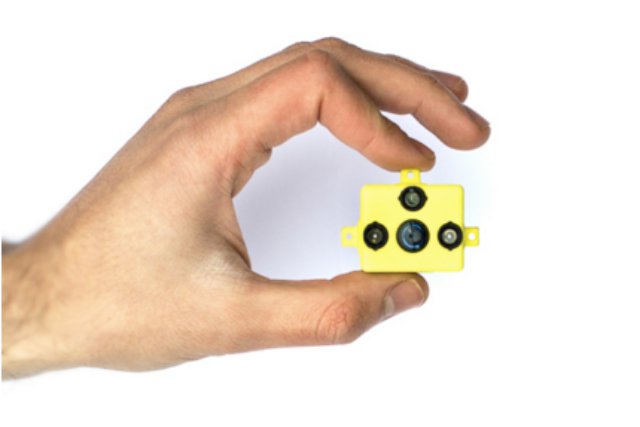 Working deeply with CERN (European Centre for Nuclear Research) in 2012, French startup Terabee has taken IR-based time-of-flight (ToF) to centimetre-level, boasting update frequencies up to 1kHz for fast moving robots and drones.
Working deeply with CERN (European Centre for Nuclear Research) in 2012, French startup Terabee has taken IR-based time-of-flight (ToF) to centimetre-level, boasting update frequencies up to 1kHz for fast moving robots and drones.
The company’s lead product, TeraRanger One, is a 35x29x18mm standalone device weighing only 8 grams. Because the ToF unit only packs three eye-safe IR LEDs and a centrally-designed IR sensor to stream calibrated distances in mm, the static design is more reliable than bulkier rotating laser lidars typically used in Simultaneous Localization and Mapping (SLAM) robotic applications. Several static sensors are already designed into arrays, linear or circular, for a wider field of view (3º per unit), and a single unit was even mounted onto a motor spindle to emulate a lidar.
“The original product idea came up from a joint project at CERN, to automate the visual inspection of the Large Hadron Collider’s 27km+ tunnel”, Commercial Manager Greg Watts told EETimes Europe. The researchers evaluated a number of collision-avoidance technologies to mount on top of a small drone but soon realized that none of what was available on the market was fast and accurate enough to meet their needs, flying through the tunnel and over their complex installations.
With a detection range of 20cm to 14 meters (6m outdoors on the Type A first generation sensor, but now 14m with Type B) and its fast acquisition speed, the TeraRanger One found many other applications since then and is currently being tried by hundreds of customers, according to the company.
Terabee’s CEO Max Ruffo told us the company had already gone through several rounds of financing, raising a few million euros for its industrialization phase. “Today, we are not desperate for more cash, we are seeking strong partnerships to pursue the integration of our products and to gain access to a wider market”, Ruffo said, adding that with only about 15 shareholders (some of them working at Terabee), the privately owned company was under no external pressure.
“We have development projects with several high-profile customers and we have secured a good supply chain so we can readily ship in the thousands and hundreds of thousands of units” the CEO said, shy of disclosing any real figures.
During the Innorobo event in Paris, Terabee exhibited the TeraRanger Hub, a plug-and-play microprocessor module able to manage up to eight sensors, an entry-level rotating lidar scanner for short-range indoor applications (with one sensor mounted onto a motor spindle), and the TeraRanger Tower simultaneously streaming the distance data of eight sensors arranged in a circular fashion (with 45º between each sensor axis). A demo video was also running, showing a robot navigating autonomously through a reconfigurable maze.
The company is happy to develop custom arrangements to meet specific needs, but it is not stopping there.
Showing the tiny TeraRanger One in his hand, Ruffo unveiled his vision for the future.
“We are looking at shrinking our technology further and in fact, we are now developing multi-pixel arrays the size of this box. Eventually, we want to achieve active 3D vision with point clouds and depth as a simple output “, he concluded.
Source: EE Times

With only a 3 degree FOV, the 8 sensors on the TeraRanger Hub leaves 336 degrees of empty space between the sensors. Not very useful for SLAM or collision avoidance. So only the rotating LIDAR version can give you full 360 degree coverage at 1 to 5 Hz.